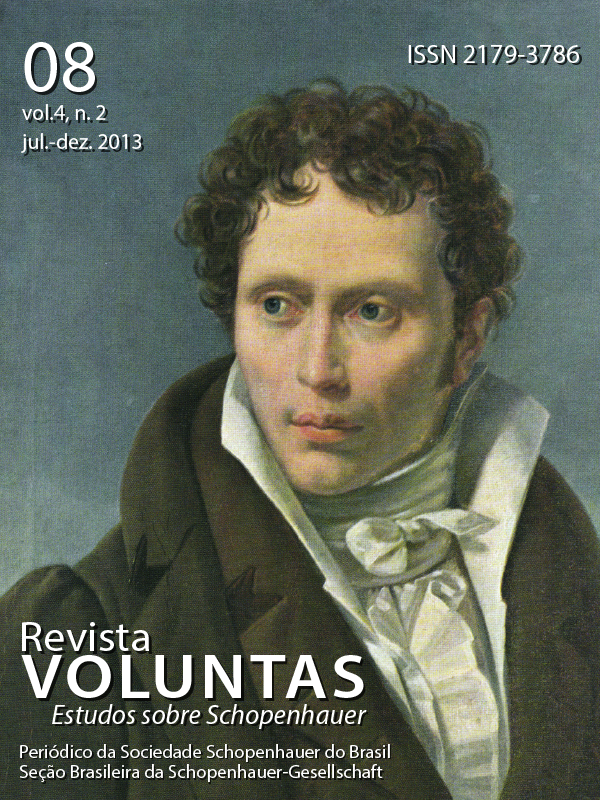On the Limit of Science: Some considerations about morphology from the perspective of Schopenhauer's theory of science
DOI:
https://doi.org/10.5902/2179378633960Keywords:
Morphology, Philosophy of science, Theory of IdeasAbstract
In his main work, Arthur Schopenhauer presents us a coherent and systematic theory of science. Nonetheless, amongst the natural sciences, there is one subject that, apparently, doesn't receive much attention from the philosopher: morphology. The goal of this paper is to situate morphology more precisely inside Schopenhauer's theory of science, pointing out the possible difficulties that the author might have met while trying to fit them consistently in the latter. To that end, we will firstly present the schopenhauerian theory of science in its more general traits; subsequently, we will try to gain a perspective on the many problems that involved morphology at the time, and on the way through which Schopenhauer introduces himself in this discussion. Thus, we will see that Schopenhauer is not at all a stranger to this debate, but that, on the contrary, it is possible to find reflexes of it throughout many moments of his thought, which transcend the scope of the mere theory of scienceDownloads
References
BÄHR, C. G. Die Schopenhauersche Philosophie in ihren Grundzügen dargestellt und kritisch beleuchtet. Dresden: Kuntze, 1857.
BEN-ARI, E. T. “Better than a Thousand Words” in: BioScience, vol. 49, nº 8, 1999, p. 602-608.
BLUMENBACH, J. F. Handbuch der Naturgeschichte. Göttingen: Dietrich, 1782.
COLEMAN, R. B. “Medical Illustration: Profession Serving Medical Progress” in: Bios, vol. 18, nº 2, 1947, p. 98-108.
FERRIS, G. F. “Entomological Illustrations” in: Science, vol. 58, nº 1501, 1923, p. 265-266.
FLANNERY, M. C. “The Visual in Botany” in: The American Biology Teacher, vol. 57, nº 2, 1995, p. 117-120.
FLOURENS, P. Cuvier. Histoire de ses travaux. Paris: Gariner, 1858.
FLOURENS, P. Cuvier. De L'unité de composition et du débat entre Cuvier et Geoffroy Saint-Hilaire. Paris: Garnier, 1865.
GOETHE, J. W. “Naturwissenschaftliche Schriften”, partes I e II in: Beutler, E. (Ed.): Gedenkausgabe der Werke, Briefe und Gespräche, vols. 16 e 17. Zürich: Artemis, 1949.
HODGES, E. R. S. “Scientific Illustration: A Working Relationship between the Scientist and Artist” in: BioScience, vol. 39, nº 2, 1989, p. 104-111.
HÜBSCHER, A. Denker gegen den Strom. Bonn: Bouvier, 1982.
KANT, I. Kritik der Urteilskraft. Hamburg: Meiner, 2009.
LINNÉ, C. Gattungen der Pflanzen und ihre natürliche Merkmale. Gotha: Ettinger, 1775.
LINNÉ, C. Fundamentos botánicos. Madrid: Imprenta real, 1788. Tradução de Angel Gomez Oriega.
MALTER, R. Arthur Schopenhauer: Transzendentalphilosophie und Metaphysik des Willens. Stuttgart: Fromman Holzboog, 1991.
MATTOS, C. V. “ʻTambém eu na Arcádia‟: Goethe, Hackert e a Pintura de Paisagem” in: Mattos, C. V. (org.) Goethe e Hackert sobre a pintura de paisagem. Cotia: Ateliê Editorial, 2008, p. 17-73.
MORGENSTERN, M. Schopenhauers Philosophie der Naturwissenschaft. Bonn: Bouvier, 1985.
MORGENSTERN, M.Die Grenzen der Naturwissenschaft und die Aufgabe der Metaphysik bei Schopenhauer“ in. LVII. Jahrbuch der Schopenhauer Gesellschaft. Frankfurt am Main: Waldemar Kramer, 1986, p. 71-93.
PALÁU Y VERDÉRA, A. Sistema de los vegetables. Madrid: Imprenta real, 1788.
RHODE, W. Schopenhauer heute. Rheinfelden / Berlin: Schäuble, 1991.
SAINT-HILAIRE, E. G. Principes de philosophie zoologique. Paris: Pichon et Didier /Rousseau, 1830.
SCHICK, J. M. “Toward an Aesthetic Marine Biology” in: Art Journal, vol. 67, nº 4, 2008, p. 62-86.
SCHOPENHAUER, A. Die Welt als Wille und Vorstellung, vols. I e II (WWV I, WWV II); Über die vierfache Wurzel des Satzes vom zureichenden Grunde (SG); Über den Willen in der Natur in: Arthur Schopenhauer: Züricher Ausgabe – Werke in zehn Bänden, vols. I-V. Zürich: Diogenes, 1977.
SCHOPENHAUER, A. Der handschriftliche Nachlaß in fünf Bänden (HN), vol. 1. München: DTV, 1985.
SCHOPENHAUER, A. Sobre a vontade na natureza (N). Porto Alegre: L&PM, 2013. Tradução de Gabriel Valladão Silva.
ZAMBONINI, F. „Schopenhauer und die modernen Naturwissenschaften“, In: XXII. Jahrbuch der Schopenhauer-Gesellschaft. Heidelberg: Carl Winters Universitätsbuchhandlung, 1935, p.44-91.
Downloads
Published
How to Cite
Issue
Section
License
The submission of original manuscripts to this journal implies the transference, by the authors, of the copyrights for printed and digital publication. The copyrights of a published manuscript belong ultimately to the author, and only the copyright for its first publication is reserved to the journal. Authors may only use the same results in other publications explicitly indicating this journal as the medium of the original publication.
Licence
Attribution-NonCommercial-ShareAlike 4.0 International (CC BY-NC-SA 4.0) - This license lets others remix, tweak, and build upon your work non-commercially, as long as they credit you and license their new creations under the identical terms.






